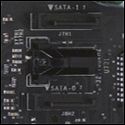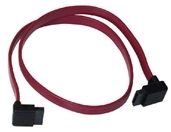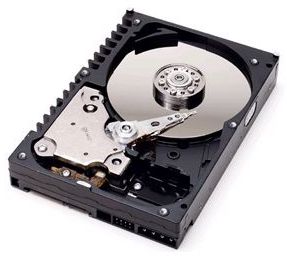Serial ATA Hard Drive
By Stephen Bucaro
Every desktop computer built since 1993 has used the IDE (Integrated Drive Electronics,
later changed to ATA for Advanced Technology Attachment) interface to handle the hard disk.
ATA/33 used a 40-wire ribbon cable to transfer data at 33MBps (megabytes per second).
At faster speeds than this, crosstalk becomes a problem.
When you increase the signal frequency on a wire, the signal tends to want to "leave"
the wire like radio waves, which interferes with the signal on adjacent wires. To eliminate
the crosstalk, a wire connected to gound was placed between each signal wire. ATA/66 and
higher use an 80-wire ribbon cable.

SATA connectors on Motherboard
New computers will begin using the SATA (Serial ATA) interface to the hard disk. Some new
motherboards come with built-in SATA support. The SATA interface does not use a ribbon cable.
Instead, it uses a cable similar to a network cable with only seven wires. Whereas IDE/ATA
transfered 32 bits of data in parallel, SATA transfers one bit at a time.
Transfering one bit at a time eliminates the crosstalk problem, but requires a much higher
operating frequency to achieve the same transfer rate. Serial ATA has a maximum transfer
speed of 150 MBps, with speed increases to 600 MBps planned for the future.

SATA cable
SATA uses a seven wire cable. The connectors snap in using a "blade and beam" connection
rather than ribbon cable sockets like IDE does. A cable with only seven wires is much easier
to install and much more reliable than a cable with 80 wires.

SATA hard drive
More Computer Anatomy Articles:
• Device Driver Basics
• Building Your Own PC! - The Motherboard is the Core of the PC
• Build Your Own Computer
• The Computers Back Connector Panel
• The Hard Disk Drive vs. The Solid State Disk
• Power Supply Form Factors
• The Chemistry of Laptop Batteries Explained
• Video - How to Buy a Motherboard
• How Hard Disks Work
• How is Data Written, Stored On, and Erased From Hard Disks?
| 
